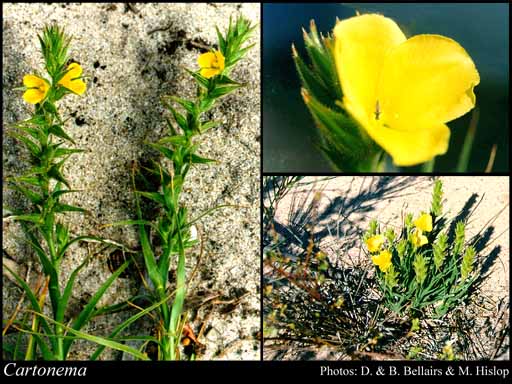- Reference
- Prodr.Fl.Nov.Holland. 271 (1810)
- Name Status
- Current

Scientific Description
Family Commelinaceae.
Habit and leaf form. Densely glandular-hairy herbs; evergreen. Plants non-succulent. Perennial; plants with a basal concentration of leaves, or with neither basal nor terminal concentrations of leaves (?). Young stems cylindrical, or oval in section (?); often breaking easily at the nodes. Mesophytic, or helophytic (?). Leaves alternate; spiral, or distichous (?); fleshy, or ‘herbaceous’ (?); sessile; sheathing. Leaf sheaths with joined margins. Leaves simple. Leaf blades entire; linear; parallel-veined. Leaves eligulate. Leaf blade margins entire. Vernation involute, or plicate (?). Vegetative anatomy. Plants with silica bodies, or without silica bodies (?). Leaf anatomy. Leaf blade epidermis without differentiation into ‘long’ and ‘short’ cells. Guard-cells not ‘grass type’. Hairs present (ciliate, and usually hairy on lower surface); glandular hairs present. Stem anatomy. Secondary thickening absent.
Reproductive type, pollination. Fertile flowers hermaphrodite. Unisexual flowers absent. Plants hermaphrodite. Floral nectaries absent (nectaries lacking). Autogamous or entomophilous (but without nectar). Pollination mechanism unspecialized.
Inflorescence and flower features. Flowers aggregated in ‘inflorescences’; in racemes. The terminal inflorescence unit cymose. Inflorescences terminal; sometimes spike-like; without involucral bracts. Flowers uni- bracteate; uni- bracteolate; regular; cyclic. Perigone tube absent. Perianth with distinct calyx and corolla; 6; 2 -whorled; isomerous; free, or joined (?); sepaloid and petaloid; different in the two whorls; yellow, or pink to purple (rarely). Calyx 3; 1 -whorled; polysepalous, or gamosepalous (?); hairy (on outer surface); regular; green. Corolla 3; 1 -whorled; polypetalous, or gamopetalous (?); regular; yellow, or pink to purple (rarely); persistent. Petals when polypetalous clawed, or sessile (?). Androecium 6 (3+3). Androecial members free of the perianth; free of one another; 2 -whorled. Androecium exclusively of fertile stamens. Stamens 6; diplostemonous. Filaments glabrous. Anthers dorsifixed, or basifixed (?); versatile, or non-versatile (?); dehiscing via pores; appendaged, or unappendaged (?). Gynoecium 3 carpelled. The pistil 3 celled. Gynoecium syncarpous; eu-syncarpous; superior. Ovary plurilocular; 3 locular. The ‘odd’ carpel (where ascertainable) anterior (?). Styles 1; apical. Stigmas 1; 1 - lobed; capitate; wet type, or dry type (?); papillate, or non-papillate (?); Group II type, Group III type, and Group IV type (?). Placentation axile. Ovules 2 per locule (usually), or 8 per locule; ascending; superposed (when 2); arillate; orthotropous to hemianatropous (?).
Fruit and seed features. Fruit non-fleshy; hairy (usually with at least a few short glandular hairs); dehiscent; a capsule. Capsules loculicidal. Seeds copiously endospermic. Endosperm not oily (mealy). Seeds with starch. Cotyledons 1, or 2 (? the second sometimes present, vestigial). Testa operculate (in the form of a characteristic callosity, the ‘embryostega’, covering the embryo). Seedling. Hypocotyl internode present, or absent (?). Seedling collar conspicuous, or not conspicuous (?). Cotyledon hyperphyll elongated, or compact (?). Coleoptile present, or absent (?). First leaf dorsiventral. Primary root ephemeral.
Physiology, biochemistry. Aluminium accumulation not found. Photosynthetic pathway: C3.
Geography, cytology, number of species. Native of Australia. Not endemic to Australia. Australian states and territories: Western Australia, Northern Territory, and Queensland. Northern Botanical Province and South-West Botanical Province.